-
Neighborhood Shot

Interviewer: We’re at Olive and Alameda in what Johnny Carson used to call “Beautiful Downtown Burbank“. Actually, downtown’s about two miles in front of us. It’s east, beyond Interstate 5 and (gag) The Los Angeles River, that concrete spillway that cuts through L.A. county, and hits the Pacific Ocean at Long Beach.
The folks in line hold tickets to the Tonight Show, and will soon be ushered into NBC Burbank’s Studio 3. Jay Leno’s guests will Jeff Foxworthy, Larry The Cable Guy, Tim Russert, and David Lee Roth, so it should be a good show. This is Burbank’s Media District. A half mile behind us is Warner Brothers, and to our right is Disney. The three story ivy covered building (just to the right of the stop light) was home to Dick Clark Productions for over 20 years, but the company moved out in 2005. Though it’s gone downhill, the Acapulco Restaurant hangs in there, perhaps thanks to hungry out of towners here to see Leno. They’d be better off grabbing a spicy chicken burrito with walnut sauce at Choza Mama, the Peruvian cafe two doors west!.
Behind the Dick Clark building is Niagara Street. Heading down Niagara and strolling two blocks, beneath rows of old pines, we turn up a driveway and come upon this bucolic scent...
-
The Garden
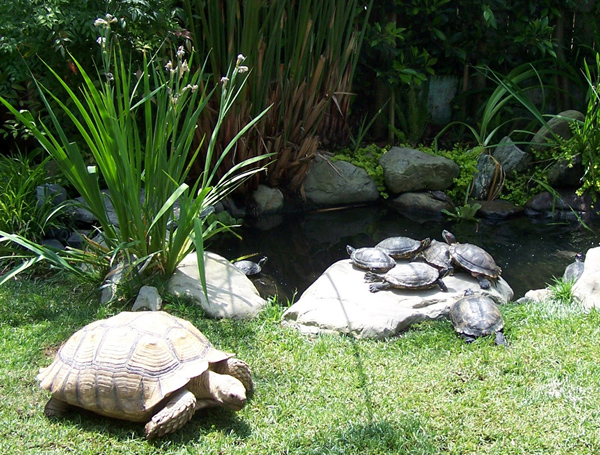
Weighing in at 90 pounds, the big land tortoise is Rocky, our cartage specialist. The two dozen water turtles, though nameless, have plenty of personality and put on fine shows at times striking odd group poses, forming pyramids, and engaging in rather startling (but slow motion) orgies.
But you didn’t click this link to observe reptiles, you’re here to meet the shop. So let’s swing around, and knock on the door.
Interviewer: Knock knock.
The Shop: Who’s there?
Interviewer: Anna.
The Shop: Anna who?
Interviewer: Anna Logue.
The Shop: That was awful. Let’s step into the shop.
-
South Bench
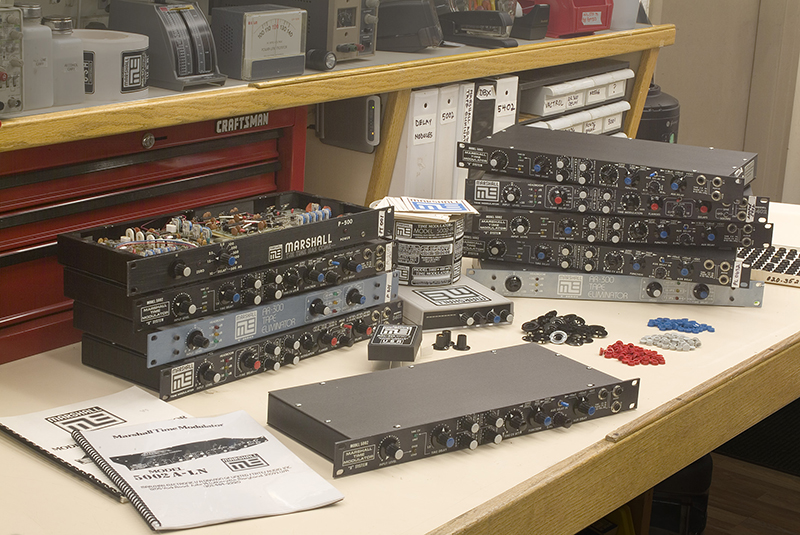
Interviewer: Holy crap, it’s bright in here!
Shop: Yep, Sylvania 5000 Kelvin “Daylight“ tubes, and lots of them. You’ll appreciate it after your eyes adjust and the pain subsides. The super bright lighting is really helpful and less fatiguing, especially for small assemblies and packed circuit boards. Anyway, here’s the first bench.
Interviewer: Wow, what’s with all the Marshall Time Modulators? Are you guys hiding Steven St. Croix in here someplace?
Shop: I wish!. In 2007, about a year after Steve passed away, David and Cholada went out to Baltimore and met with Teresa, his wife. They made a deal to take over sales and service of Time Modulators and Tape Eliminators. There were a bunch of unfinished units in Steve’s house that had been gathering dust for 25 years, and slowly turning them into brand new models. We have all the parts and documentation, and we’re also servicing these models for people. David says it’s his favorite project ever.
Interviewer: Your guys service a lot of older audio gear that other shops won’t even touch.
Shop: Yeah––AMS, Quantec, the Songbird Cyclosnic Panners, EMT 250’s and 251’s – all kinds of great stuff.
Interviewer: How about Publisons? The Infernal Machine and those other models?
Shop: The boss can’t stand that company and he says all Publison models are banned from this place.
Interviewer: I couldn’t agree more! Let’s move on.
-
David and Greg's Benches
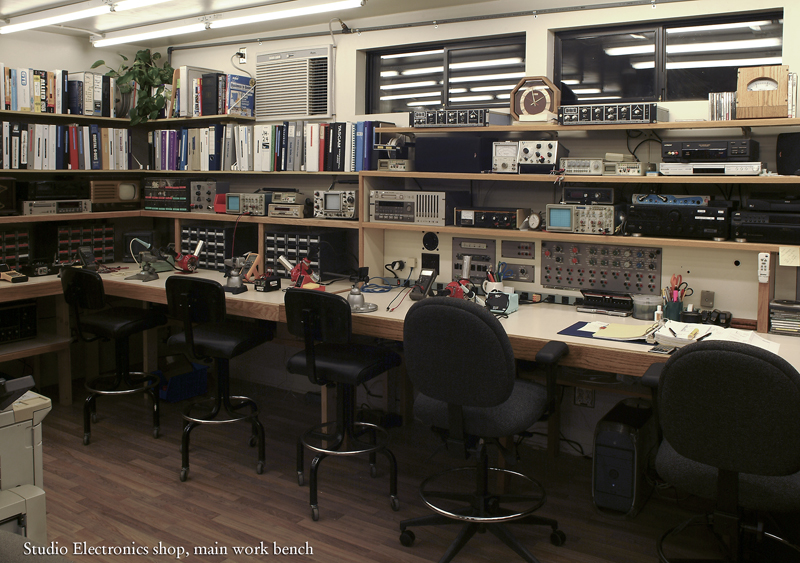
Shop: This is our biggest workbench. Greg Granieri has the left side and David’s area is on the right.
Interviewer: You’re so organized!
Shop: (Laughs) That’s what everyone says when they see me the first time. Kulka says that for each hour spent working on gear, there’s another hour handling parts, putting stuff in the right place, cleaning up and keeping the place shipshape. It’s a huge amount of background work.
Interviewer: No wonder your shop looks very neat.
Shop: Have you seen the shops in some of those audio dealers and studios? They’re atrocious. Old junk and parts strewn from here to breakfast, trash all around, client gear piled up in disarray. It’s a miracle they get anything done, and you really question the quality of the work. We’re a clean, well lighted sanctuary in the jungle of pro audio madness.
Interviewer: What’s the big gray panel with all the knobs?
Shop: That a big switch panel for test gear and monitoring that David designed and had built. It’s connected to a bunch of generators, analyzers, meters, and scopes along with the CD player and stereo system. It can switch between +4 balanced, +4 unbalanced, and RCA -10, and routes signals in every way that you could imagine. It also has AES and SPDIF in and out, DB-25 8-channel connectors with switching, and a powered interface box with adaptor cables for API, Neve, dbx, Harrison, MCI, and Aphex modules. You can plug just about anything in and test audio instantly.
Interviewer: Excuse me, did you say Harrison? Your people work on Harrison gear?
Shop: Well, occasionally. David grew up with it at United/Western and says he still has a soft spot for Harrison stuff. Did you know that before getting into getting into console design, Dave Harrison was at King Records in Cincinnati? He recorded Mother Popcorn and a bunch of other James Brown stuff.
Interviewer: (Yawns) Fascinating. Tell me more about these dials and gizmos we’re seeing.
Shop: Tucked away on the right are four 8 ohm 300 watt load resistors, both wirewound and non-inductive, for testing amps and power supplies. All the benches have varias for testing gear with short circuits, and for gradually powering up older gear that’s hasn’t run for a while.
Interviewer: David and crew must have spent a lot of time setting all this up!
Shop: It’s a unending process – I get tired just thinking about it. The 200 or so bench outlets are switched on and off by relays, controlled by a master switch near the door. The benches all have air hoses with nozzles. Steve Lange piped air all through the shop, with all sorts of filters and regulators. He also modified six HP 3310B function generators for the benches, with stepped attenuators and balanced outputs. David’s design. Of course, we have one or two Ethernet ports on each bench and all sorts of computer gear, including a big HP printer that does hi-res, oversize pages for patchbay labels and large schematics.
Hey, here’s our collection of schematics and manuals. We’ve got a lot of incredibly rare documents here. You wouldn’t believe what the guys went through to get some of this material!
Interviewer: Quite a setup. But so far I haven’t seen any people. How about a peek at your staff?
Shop: OK, here’s a look at everyone working at their benches.
-
Our Staff
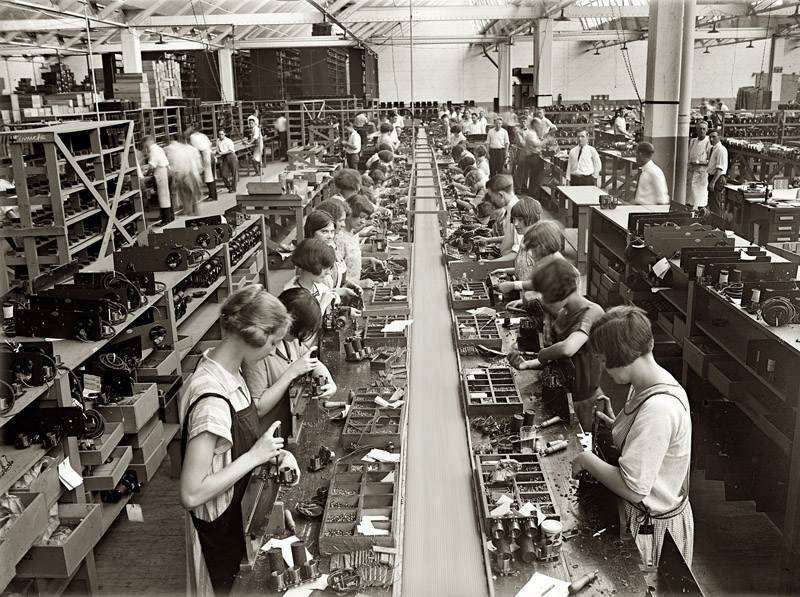
Interviewer: (Rolls eyes) For an inanimate object, you‘re so witty.
Let’s continue the tour. You‘ve got a massive quantity of parts in here!
Shop: David‘s a nut for collecting and categorizing parts but in the last few years, we‘ve really gone wild. We stock virtually every transistor, FET, diode, regulator, logic gate and opamp ever used in pro audio gear. The shelves have nearly every switch and connector the staff could every want, many of them by the hundreds. We have tubes and tube sockets, all sorts of transformers, thousands of pots, special parts for gear like UREI, AMS, Eventide, dbx, Tascam, EMT, and Quantec -- really, it‘s amazing. We just might have the most complete pro audio spares inventory of any shop in the world. Step over here to the right, I want to show you our stock of capacitors.
-
Capacitors and Prasit
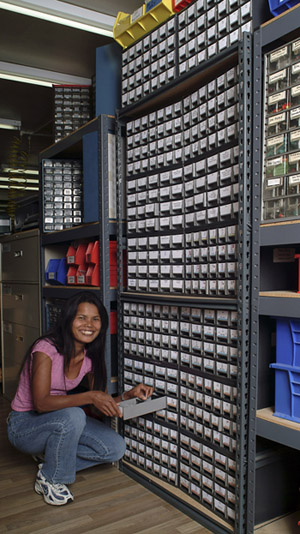
Shop: Hey Prasit, what’s up?
Prasit: I need a 10 microfarad 35 volt axial for a dbx compressor.
Interviewer: I suspect she’ll find one. That’s a lot of capacitors.
Shop: We’d always had a lot in stock but a few years ago, a local store called Pacific Radio decided to stop selling capacitors, and we bought out their inventory. I was quite pleased at first, but we soon realized that even though we now had most almost every style and value ever needed – what about the others? David and Cholada spent a month building a capacitor database and then buying up every weird style and value they needed to make the stock complete. Besides the usual electrolytic axials and radials they bought Orange Drops, micas, disks, polypropolenes, metalized film, ceramic – you name it. Japanese gear uses a lot of non polarized caps, so we stocked up and created a whole separate section of NP’s. Of course we also have hundreds of big can type capacitors, along with variable caps, precision caps, and safety caps.
Interviewer: What’s a safety capacitor?
Shop: Safety capacitors are used to replace old paper capacitors that were used across the AC line in older tube gear. Sometimes they’re used to provide a pseudo ground on a piece of gear with an ungrounded AC cord. Safety capacitor are extra rugged. Unlike some other capacitor types, if they fail, they won’t explode.
Interviewer: There’s a lot of voodoo and myths about capacitors.
Shop: Yeah, and David and the guys know that lots of it is bunk. Capacitors are crucial to sonics though, and any piece of gear that’s more than about 10 years old ought to have its caps replaced, or at least checked.
Interviewer: What’s the best way to test a capacitor?
Shop: Good question, but there’s no easy answer. Lots of guys use inexpensive digital meters but they can be very inaccurate, and generally won’t see leakage, which is a very common failure. ESR meters are neat, but they’re not precise either. And for tube gear, high voltage performance is very important, but few modern instruments can test at high voltages.
A few years ago we picked up a TO-5 Capanalyzer, a high quality instrument made in the 60’s by Sprague, a major capacitor manufacturer that’s still around. Ironically, most of the capacitors in the T0-5were bad, and it had other problems. David restored it but no calibration info was available, so he reverse engineered the circuit and created a detailed alignment procedure. Other Sprague owners jumped on it. (The document is available here on the antiqueradios website.
The TO-5 is great for checking capacitors, especially high the voltage types found in tube gear. It measures capacitance with great accuracy, checks leakage up to 600 volts, and measures insulation resistance, up to 20 billion ohms. Here are some examples of recap costs.
Interviewer: That’s the most shameless, thinly veiled, self serving promotion I have ever heard.
Shop: Bite me.
Interviewer: Let’s step over to this other group of parts, which is clearly your resistor stock.
-
Wall of Resistance
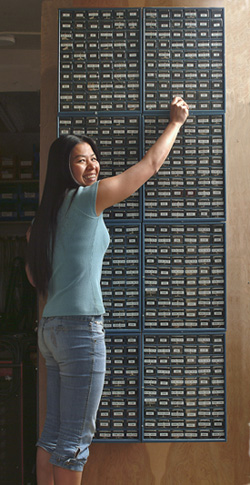
Shop: Yes, that’s what we call the Wall Of Resistance. Cholada here is pretending to check the 604 ohm drawer.
Interviewer: : That lady is gorgeous. No man could resist her!
Shop: The lady is Mr. Kulka’s wife, so back off. Anyway, we never need to leave ohm (grins) to buy a resistor, because every value is stocked. All the standard 5% values, and every 1% metal film value, too. We also have a large selection of power resistors, faders, and all pot and trimmer values.
Interviewer: : I’ve never seen a shop with so many resistors.
Shop: Every resistor you could ever want, from zero ohms to 100 megs.
Interviewer: Why would I ever want a zero ohm resistor?
Shop: Zero ohm resistors are neat for bridging two points on a circuit board. Also, some precision applications use two resistors in series, which are selected during testing. If for example the technician finds that 1000 ohms is the ideal value he can use a 1k resistor and a zero ohm resistor for the pair.
Interviewer: Do you also stock infinity ohm resistors?
Shop: Eat my shorts. You know, the other night I dreamed that we expanded the Wall Of Resistance, making it much larger
-
Mega Resistance
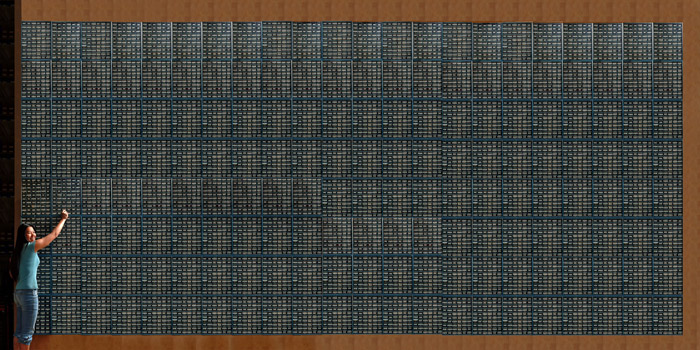
Interviewer: : If I took all the resistors in this photo and soldered them in series, what would the total resistance be?
Shop: A lot less than infinity.
Interviewer: : Let’s continue our circuit of the shop.
-
Elco Machine
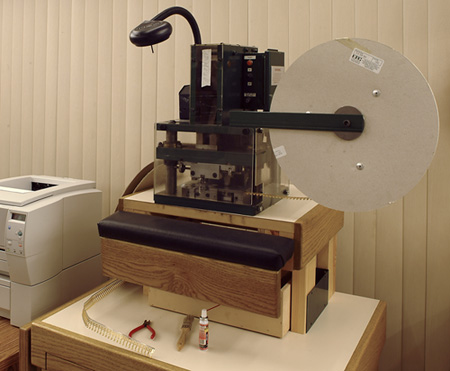
Interviewer: What’s that contraption?
Shop: That’s our Elco machine. It’s a pneumatic machine that crimps Elco pins on cables. The reel has a roll on pins that feed into the machine. The operator inserts a prepped wire end into a small slot on that plexiglass panel in front, steps on a footswitch, and the machine makes a perfect crimp. For our installations we use Bittree patchbays, which use Elco connectors. Each patchbay has 288 pins, so this machine is much faster and easier than hand crimping.
Interviewer: I can imagine!
Shop: David was given the machine about 6 years ago, but it had changed hands many times and was broken. Getting it running nearly drove him nuts. It uses compressed air to drive a large piston, but the piston shaft was broken. John Costa at Westcam in North Hollywood, who does all our custom panels, is a genius with machines and said he’d give it a try. Poor John spent months getting the crazy thing fixed and working right.
John got the piston repaired without too much trouble but the machine had other problems, and the mechanisms were out of adjustment. They phoned the manufacturer, but learned that the original owner never fully paid for it, the company wasn’t too willing to help. John finally figured out all the tweaks and David had that workstation build with a work light, fold out table, tool drawer, and adjustable armrest. Sounds great, huh? It worked great for about two months, then froze up and died. John came over and sweated over it day after day, without success. David said he was ready take it out on a boat and drop it into Santa Monica Bay. But John finally got it all sorted out, and now the machine works perfectly.
Interviewer: Well, we’ve reached the end of our little tour. Thanks for your time.
Shop: You know, I’d like to get in one more promotional plug.
Interviewer: : I’m outta here, but go for it.
Shop: We hope you like what you’ve seen, so, whether you need an LA3A serviced...

Or maybe you have an AMS or two that need repair.

Or need some nice old outboard piece restored (like this RCA BA-6A)...

Or need a special cable built...

Or need a small Machine Room installed (hello, Warner Brothers)...

Or need a minor repair on your console...

Send us an email...

Or give us a call
 Thank you very much from us.........BACK TO HOME PAGE
Thank you very much from us.........BACK TO HOME PAGE

